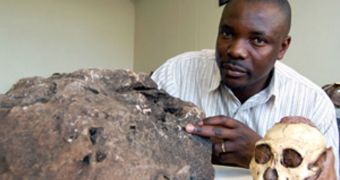A few days ago, researchers in Africa announced the discovery of a hominid ancestor who lived more than 2 million years ago. The fossilized remains of this individual are very well preserved, and contain extensive bone fragments, which scientists will now analyze thoroughly.
The remarkable discovery was made by experts at the Wits Institute for Human Evolution, which is based at the University of the Witwatersrand, in Johannesburg, South Africa, Science Blog reports.
According to the team, the earthly remains of the ancient ancestor were found inside a large rock. Early analysis of the sample revealed that the bones belong to a skeleton type consistent with Australopithecus sediba, which was first discovered back in 2009.
The skeleton type, known as Karabo, was found in the so-called Cradle of Humankind, at the Malapa Site. The creatures that sported it are believed to have belonged to a species of Australopithecus that lived during the early stages of the Pleistocene epoch.
Details of the discovery were presented during an announcement held at the Shanghai Science and Technology Museum in Shanghai, China, on July 13. The presenter was WIHE Reader in Palaeoanthropology and the Public Understanding of Science, Professor Lee Berger.
“We have discovered parts of a jaw and critical aspects of the body including what appear to be a complete femur (thigh bone), ribs, vertebrae and other important limb elements, some never before seen in such completeness in the human fossil record,” Berger said.
“This discovery will almost certainly make Karabo the most complete early human ancestor skeleton ever discovered. We are obviously quite excited as it appears that we now have some of the most critical and complete remains of the skeleton, albeit encased in solid rock,” he added.
“It’s a big day for us as a team and for our field as a whole,” the expert went on to say. He explained that the rock housing the remnants is about 1 meter (3 feet) in diameter, and that getting the bones out will take a lot of fine work.
The fact that the stone contains bones was discovered after Charlotte Maxeke Hospital radiologist Jackie Smilg, Berger's wife, conducted an imaging session of the artifact using state-of-the-art computer tomography (CT) techniques.
Figuring out the early history of our ancestors is an extremely complex task, one made even more difficult by the fact that not many fossils from that time endured. However, over the past few years, steady progress has been made.

 14 DAY TRIAL //
14 DAY TRIAL //